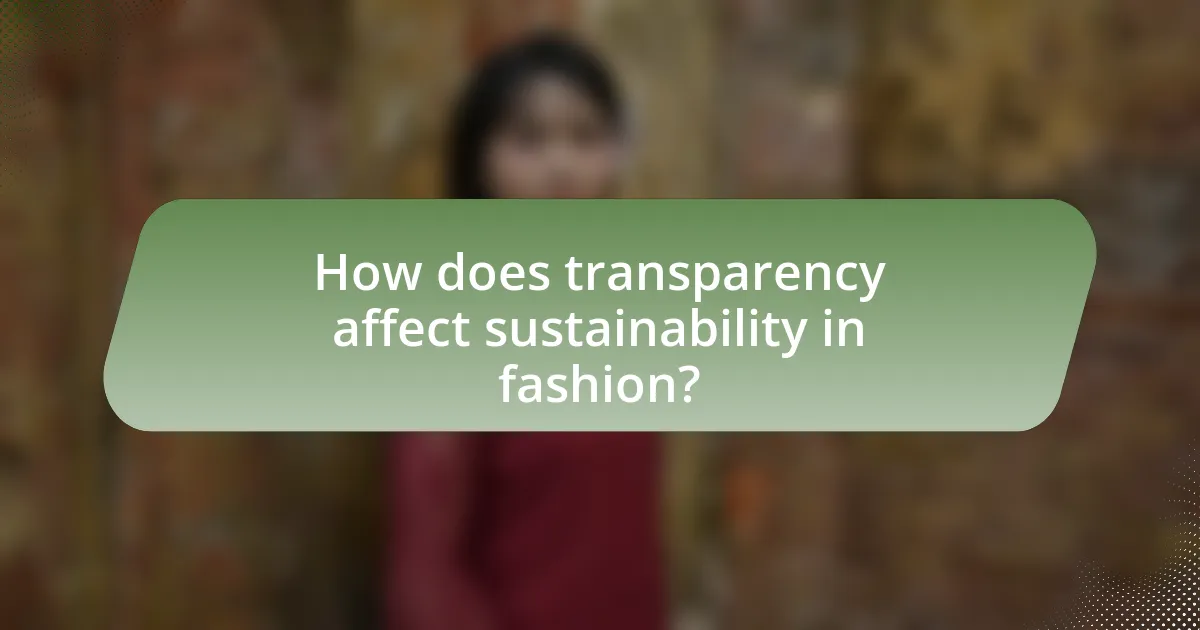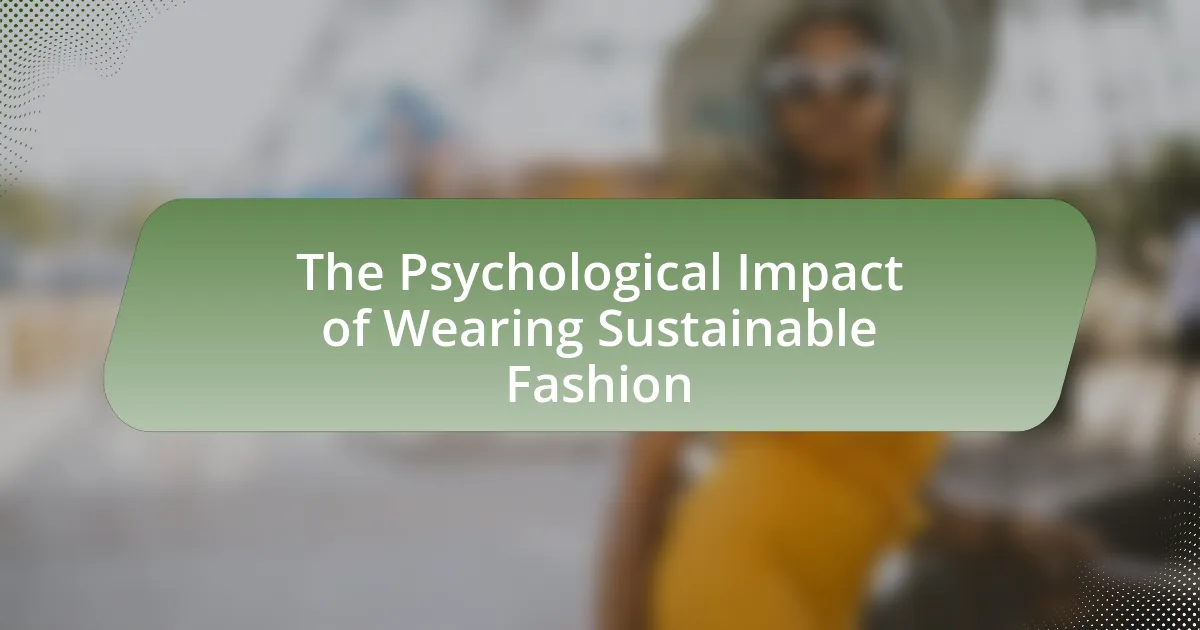Transparency in fashion supply chains is essential for promoting ethical practices and building consumer trust. The article explores the significance of transparency, highlighting its role in combating exploitation, improving labor conditions, and fostering sustainable practices. It discusses the ethical implications of a lack of transparency, the impact on consumer trust, and the key components necessary for achieving transparency, such as traceability and disclosure of sourcing practices. Additionally, the article addresses the challenges brands face in implementing transparency, the barriers to information sharing, and the strategies that can enhance transparency, ultimately leading to improved brand loyalty and economic benefits.

What is the Importance of Transparency in Fashion Supply Chains?
Transparency in fashion supply chains is crucial for fostering ethical practices and consumer trust. It enables brands to disclose sourcing, production processes, and labor conditions, which helps combat issues like exploitation and environmental harm. For instance, a 2020 report by Fashion Revolution found that 73% of consumers want to know the origins of their clothing, indicating a strong demand for accountability. Furthermore, transparency can enhance brand loyalty, as consumers increasingly prefer to support companies that prioritize ethical standards.
Why is transparency crucial in the fashion industry?
Transparency is crucial in the fashion industry because it fosters accountability and trust among consumers, brands, and suppliers. When fashion companies disclose their supply chain practices, it allows consumers to make informed choices, promoting ethical consumption. According to a 2021 report by Fashion Revolution, 77% of consumers want to know where their clothes come from, highlighting the demand for transparency. Furthermore, transparency can lead to improved labor conditions and environmental practices, as companies are held accountable for their actions. This accountability is essential for building a sustainable and ethical fashion industry.
What are the ethical implications of a lack of transparency?
A lack of transparency in fashion supply chains leads to significant ethical implications, primarily fostering exploitation and undermining accountability. When companies do not disclose their sourcing practices, it becomes difficult to ensure fair labor conditions, as workers may face unsafe environments, low wages, and human rights violations without oversight. For instance, the 2013 Rana Plaza collapse in Bangladesh, which resulted in over 1,100 deaths, highlighted the dire consequences of opaque supply chains, revealing that many brands had little knowledge of the conditions in their factories. Furthermore, the absence of transparency erodes consumer trust, as buyers are increasingly concerned about the ethical standards of the products they purchase. This lack of trust can ultimately harm brand reputation and financial performance, as consumers are more likely to support companies that demonstrate ethical practices and transparency.
How does transparency impact consumer trust?
Transparency significantly enhances consumer trust by providing clear and accessible information about products and their origins. When brands openly share details regarding their supply chains, production processes, and sourcing practices, consumers feel more informed and empowered in their purchasing decisions. Research conducted by the Nielsen Global Corporate Sustainability Report indicates that 66% of consumers are willing to pay more for sustainable brands, highlighting the direct correlation between transparency and consumer willingness to engage with a brand. Furthermore, transparency reduces the likelihood of misinformation and fosters a sense of accountability, which is crucial in building long-term relationships with consumers.
What are the key components of transparency in fashion supply chains?
The key components of transparency in fashion supply chains include traceability, disclosure of sourcing practices, ethical labor standards, and environmental impact reporting. Traceability allows consumers to track the origin of materials and the journey of products through the supply chain, ensuring accountability. Disclosure of sourcing practices involves brands openly sharing information about their suppliers and manufacturing processes, which fosters trust. Ethical labor standards ensure that workers are treated fairly and work in safe conditions, which is crucial for social responsibility. Environmental impact reporting provides insights into how production affects the environment, enabling consumers to make informed choices. These components collectively enhance consumer trust and promote sustainable practices within the fashion industry.
What information should brands disclose to ensure transparency?
Brands should disclose information regarding their supply chain practices, including sourcing locations, labor conditions, and environmental impact. Transparency in these areas allows consumers to understand the ethical implications of their purchases. For instance, according to a 2021 report by Fashion Revolution, 75% of consumers want to know where their clothes come from, highlighting the demand for clear supply chain information. Additionally, brands should provide details on their sustainability initiatives and any certifications they hold, as this fosters trust and accountability.
How do supply chain mapping and traceability contribute to transparency?
Supply chain mapping and traceability enhance transparency by providing a clear visualization of the entire supply chain process and enabling the tracking of products from origin to consumer. This clarity allows stakeholders to understand the flow of materials, labor practices, and environmental impacts associated with each stage of production. For instance, a study by the Fashion Transparency Index indicates that brands that implement comprehensive supply chain mapping can disclose information about their suppliers, which fosters accountability and builds consumer trust. By ensuring that every step is documented and accessible, supply chain mapping and traceability empower consumers to make informed choices and encourage brands to adhere to ethical practices.
What challenges do brands face in achieving transparency?
Brands face significant challenges in achieving transparency, primarily due to complex supply chains and varying levels of compliance among suppliers. The intricate nature of global supply chains often involves multiple tiers of production, making it difficult for brands to track and verify the practices of every supplier. Additionally, many suppliers may not adhere to the same ethical standards or transparency requirements, leading to inconsistencies in reporting and accountability. According to a 2021 report by Fashion Revolution, 60% of brands do not disclose their suppliers, highlighting the lack of visibility in the industry. Furthermore, the fear of reputational damage and competitive disadvantage can deter brands from fully disclosing information about their supply chains.
What are the barriers to information sharing in the fashion supply chain?
Barriers to information sharing in the fashion supply chain include lack of trust among stakeholders, data privacy concerns, and technological limitations. Stakeholders often hesitate to share sensitive information due to fears of competitive disadvantage or misuse, which undermines collaboration. Additionally, varying data protection regulations across regions create complexities that hinder open communication. Technological limitations, such as outdated systems and lack of interoperability between platforms, further obstruct seamless information exchange. According to a report by McKinsey & Company, 70% of fashion executives cite these barriers as significant challenges to achieving transparency in their supply chains.
How can brands overcome resistance to transparency from suppliers?
Brands can overcome resistance to transparency from suppliers by fostering collaborative relationships and demonstrating the benefits of transparency. Establishing trust through open communication and shared goals encourages suppliers to engage in transparent practices. For instance, brands can provide training and resources that help suppliers understand the value of transparency, such as improved consumer trust and potential market advantages. Research indicates that companies with transparent supply chains can enhance their brand reputation, leading to increased customer loyalty and sales. By highlighting these benefits and actively involving suppliers in the process, brands can effectively reduce resistance and promote a culture of transparency.

How does transparency affect sustainability in fashion?
Transparency significantly enhances sustainability in fashion by enabling consumers to make informed choices about the environmental and ethical implications of their purchases. When brands disclose information about their supply chains, including sourcing practices, labor conditions, and environmental impact, it fosters accountability and encourages sustainable practices. For instance, a 2021 report by the Fashion Transparency Index found that brands with higher transparency scores are more likely to implement sustainable practices, such as using eco-friendly materials and ensuring fair labor conditions. This correlation illustrates that transparency not only builds consumer trust but also drives the industry towards more sustainable operations.
What role does transparency play in promoting sustainable practices?
Transparency plays a crucial role in promoting sustainable practices by enabling stakeholders to access information about supply chain operations and environmental impacts. When companies disclose their sourcing, production methods, and labor conditions, it fosters accountability and encourages ethical behavior among suppliers. For instance, a study by the Fashion Transparency Index found that brands that are more transparent about their practices tend to have better sustainability scores, as they are held accountable by consumers and advocacy groups. This increased visibility allows consumers to make informed choices, driving demand for sustainable products and pressuring companies to adopt greener practices.
How can transparency help reduce environmental impact?
Transparency can help reduce environmental impact by enabling consumers and stakeholders to make informed choices about sustainable practices within the fashion supply chain. When companies disclose information about their sourcing, production processes, and environmental policies, it fosters accountability and encourages the adoption of eco-friendly practices. For instance, a study by the Global Fashion Agenda found that increased transparency can lead to a 30% reduction in greenhouse gas emissions in the fashion industry by promoting sustainable materials and ethical labor practices. This evidence demonstrates that transparency not only empowers consumers but also drives companies to minimize their ecological footprint.
What are the social benefits of transparent supply chains?
Transparent supply chains provide significant social benefits, including enhanced labor rights and improved community welfare. By ensuring visibility into supply chain practices, companies can better monitor working conditions, leading to the reduction of labor exploitation and the promotion of fair wages. For instance, a study by the Ethical Trading Initiative found that transparency can lead to a 20% increase in compliance with labor standards among suppliers. Furthermore, transparent supply chains foster consumer trust and engagement, as consumers increasingly demand ethical practices. This shift not only encourages brands to adopt responsible sourcing but also empowers communities by creating jobs and supporting local economies.
How does consumer demand influence transparency in fashion supply chains?
Consumer demand significantly influences transparency in fashion supply chains by driving brands to disclose information about their sourcing and production practices. As consumers increasingly prioritize ethical and sustainable practices, brands respond by providing greater visibility into their supply chains to meet these expectations. For instance, a 2021 survey by McKinsey & Company found that 67% of consumers consider sustainability when making purchasing decisions, prompting brands to adopt transparency measures such as supply chain mapping and public reporting on labor conditions. This shift not only enhances consumer trust but also encourages accountability among suppliers, ultimately leading to improved ethical standards within the industry.
What trends are driving consumers to seek transparency?
Consumers are increasingly seeking transparency due to rising awareness of ethical and environmental issues in the fashion industry. This trend is driven by a growing demand for sustainable practices, as evidenced by a 2021 McKinsey report indicating that 67% of consumers consider sustainability when making purchasing decisions. Additionally, social media has amplified consumer voices, leading to greater scrutiny of brands’ practices and a desire for accountability. The combination of these factors has created a marketplace where transparency is not just preferred but expected, influencing brand loyalty and purchasing behavior.
How can brands respond to consumer demands for transparency?
Brands can respond to consumer demands for transparency by implementing clear communication strategies about their supply chains and production processes. This includes providing detailed information on sourcing materials, labor practices, and environmental impact. For instance, a 2021 survey by McKinsey & Company found that 67% of consumers consider sustainability and transparency important when making purchasing decisions. By adopting practices such as publishing sustainability reports and utilizing blockchain technology to trace product origins, brands can enhance their credibility and build trust with consumers.

What are the best practices for implementing transparency in fashion supply chains?
The best practices for implementing transparency in fashion supply chains include adopting traceability technologies, engaging in open communication with stakeholders, and conducting regular audits. Traceability technologies, such as blockchain, allow brands to track the origin of materials and the journey of products through the supply chain, ensuring accountability. Open communication fosters trust and allows consumers to access information about sourcing and labor practices. Regular audits, both internal and third-party, help verify compliance with ethical standards and identify areas for improvement. According to a 2021 report by McKinsey & Company, brands that implement these practices can enhance consumer trust and brand loyalty, ultimately leading to better financial performance.
What strategies can brands adopt to enhance transparency?
Brands can enhance transparency by implementing supply chain traceability, engaging in open communication, and adopting third-party audits. Supply chain traceability allows brands to track the origin of materials and the processes involved in production, which builds consumer trust. Open communication involves sharing information about sourcing practices, labor conditions, and environmental impact, fostering a culture of honesty. Third-party audits provide an objective assessment of compliance with ethical standards, ensuring accountability. According to a 2021 report by McKinsey & Company, brands that prioritize transparency can improve consumer loyalty and brand reputation, as 66% of consumers are willing to pay more for sustainable brands.
How can technology facilitate transparency in supply chains?
Technology facilitates transparency in supply chains by enabling real-time tracking and data sharing among all stakeholders. For instance, blockchain technology allows for immutable records of transactions, ensuring that every step of the supply chain is documented and verifiable. According to a 2020 report by the World Economic Forum, companies using blockchain can reduce supply chain fraud by up to 50%. Additionally, Internet of Things (IoT) devices provide continuous monitoring of goods, allowing for immediate updates on their status and location, which enhances accountability. These technological advancements collectively improve visibility, foster trust, and promote ethical practices within supply chains.
What role do certifications and standards play in ensuring transparency?
Certifications and standards play a crucial role in ensuring transparency by providing a framework for accountability and verification in fashion supply chains. These certifications, such as Fair Trade or Global Organic Textile Standard, establish specific criteria that companies must meet, which helps consumers identify ethical practices. For instance, a study by the Ethical Fashion Forum indicates that brands with recognized certifications are 50% more likely to be perceived as transparent by consumers. This verification process fosters trust, as it allows stakeholders to assess compliance with ethical and environmental standards, thereby enhancing overall transparency in the industry.
What are the potential outcomes of increased transparency in fashion supply chains?
Increased transparency in fashion supply chains can lead to enhanced consumer trust, improved ethical practices, and greater accountability among brands. When consumers have access to information about sourcing, labor conditions, and environmental impact, they are more likely to support brands that align with their values. A study by McKinsey & Company found that 66% of consumers are willing to pay more for sustainable brands, indicating that transparency can drive sales. Furthermore, transparency encourages brands to adopt fair labor practices and sustainable sourcing, as they are held accountable by informed consumers and regulatory bodies. This shift can ultimately lead to a more sustainable fashion industry, reducing negative environmental impacts and promoting social responsibility.
How can transparency lead to improved brand loyalty?
Transparency can lead to improved brand loyalty by fostering trust between consumers and brands. When brands openly share information about their supply chains, production processes, and sourcing practices, consumers feel more informed and empowered to make ethical purchasing decisions. A study by Cone Communications found that 87% of consumers are more likely to purchase from a company that advocates for social and environmental issues, indicating that transparency aligns with consumer values. Additionally, brands that demonstrate accountability and ethical practices can differentiate themselves in a competitive market, leading to stronger emotional connections with consumers and increased loyalty.
What economic benefits can arise from transparent practices?
Transparent practices in fashion supply chains can lead to increased consumer trust, which directly boosts sales and brand loyalty. When companies openly share information about their sourcing, production processes, and labor conditions, consumers are more likely to support those brands, as evidenced by a 2021 study from McKinsey & Company, which found that 66% of consumers are willing to pay more for sustainable brands. Additionally, transparency can reduce operational risks and costs by identifying inefficiencies and unethical practices early, leading to better resource allocation and compliance with regulations. This proactive approach can save companies significant amounts in potential fines and reputational damage, as highlighted by a report from the World Economic Forum, which states that companies with transparent supply chains can reduce costs by up to 20%.
What practical steps can brands take to improve transparency?
Brands can improve transparency by implementing traceability systems that track the origin of materials and the production processes involved. By utilizing blockchain technology, brands can provide consumers with verifiable information about the supply chain, ensuring that each step is documented and accessible. For instance, companies like Everledger have successfully used blockchain to trace the provenance of diamonds, demonstrating the effectiveness of this approach in enhancing transparency. Additionally, brands should conduct regular audits of their suppliers and publish the results, which fosters accountability and builds consumer trust. According to a 2021 report by Fashion Revolution, 73% of consumers want to know more about the supply chain of their clothing, highlighting the demand for transparency in the industry.




